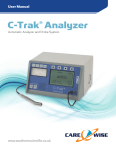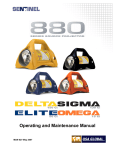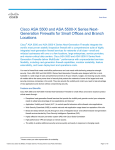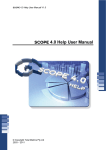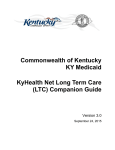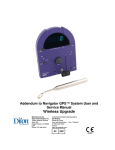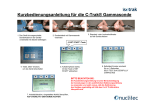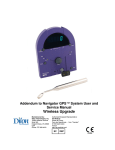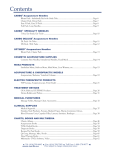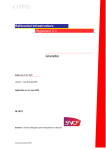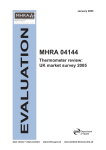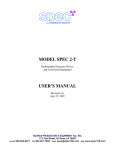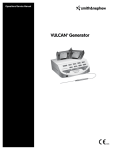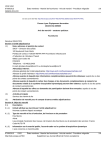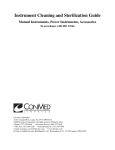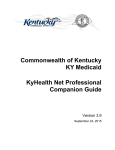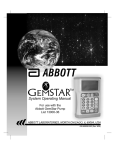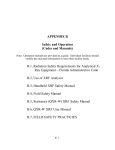Download C-Trak® Galaxy
Transcript
User Manual C-Trak Galaxy ® Gamma Probe System www.southernscientific.co.uk Contents 1.0 Introduction 3 8.0 Use of Optional Accessories 22 1.1 C-Trak® Analyzer and Probe Introduction 3 8.1 C-Trak® Galaxy System Cart 22 1.2 C-Trak Getting Started Guide 3 8.2 Printer 22 1.3 C-Trak® Quick Reference for Surgical Use 4 8.3 Lechner Collimator 22 8.4 Indium Shield Assembly 22 ® 2.0 Getting acquainted with the C-Trak® System 5 2.1 Front Panel 5 2.2 Bottom Panel 6 2.3 Right Panel 6 2.4 Accessing the Display Screens (Sections 1-14) 7 - 16 9.0 International Symbols Appendix A Warranty, Receiving Examination, Returns and Repairs 3.0 Calibration Guidelines 17 Appendix B 3.1 Isotope Check Source (Sections 1-2) 17 Troubleshooting FAQ 3.2 Check Source Holder Use 17 3.3 Performing Calibration (Systems Test) 17 4.0 Pre-Surgery Set Up 18 4.1 Before Power Is Turned On 18 4.2 Background Test 18 Error Messages EMC Precautions 5.1 Use of Sheath 18 Proof of Cleaning Statement 5.2 Disinfecting 18 5.3 Decontamination 5.4 Sterilization 6.0 Safety Considerations 20 6.1 Error Messages 20 6.2 Power Supply Requirements 20 6.3 Disassembly 20 6.4 Radioactive Concerns 20 6.5 Use of Electrosurgical Devices 20 6.6 Use of Accessory Equipment 20 6.7 Probe Handling Guidelines 20 7.0 Technical Specifications 21 7.1 Power / Probe Overload Cutoff 21 7.2 LCD Display 21 7.3 Probe Cable Connector 21 7.4 Size 21 7.5 Weight 21 7.6 Finish 21 7.7 Mode of Operation 21 7.8 Serial Numbers 21 7.9 Environmental Limits 21 7.10 Label Legibility 21 2 www.southernscientific.co.uk 25 26 Appendix D Appendix E 19 24 Appendix C 5.0 Sterile Practicies, Cleaning, and Disinfecting 18 18 - 19 23 27 28 Appendix F Care Wise Products List, Instructions for Detaching C-Trak® Cable 29 - 30 Appendix G Manufacturer’s Radioactive Material Exempt Quantity Statement 30 Probe Handling Information 31 Care Wise contact information: Europe, United Kingdom and Rest of World: Southern Scientific, Ltd. Scientific House, The Henfield Business Park Shoreham Road, Henfield, West Sussex BN5 9SL, United Kingdom Tel: +44 (0)1273 497600 Fax: +44 (0)1273 497626 Web: www.southernscientific.co.uk United States: Care Wise c/o LabLogic Systems Inc., 1040 East Brandon Boulevard, Brandon, Florida, 33511-5509 USA Tel: US (813) 626-6848 Fax: US (813) 620-3708 Web: www.carewise.com 1.0 Introduction 1.1 C-Trak® Analyzer and Probe Introduction 1.2 C-Trak® Getting Started Guide The C-Trak® Galaxy system has been designed to detect and quantify the nuclear radiation from gamma emitting isotopes ranging in energy emissions between 27-600 keV. A clear display of numeric quantities and an audible signal convey an increase or decrease in radiation detection allowing the surgeon to localize radiolabeled tissue for excision. (1) Attach the Monitor to the Stand. Place the stand on a flat, stable surface. Slide computer onto stand carefully until the ‘Quick Release’ bracket on the back of the computer locks into the bracket on the stand. Alternatively, if using an accessory cart, slide computer onto the bracket mounted on the cart. The system is comprised of the C-Trak® Galaxy touchscreen analyzer and one or more of the OmniProbe® family of probes. The OmniProbe® and OmniProbe®-EL are capable of detecting gamma ray energies up to 364 keV. The OmniProbe®-PET is capable of detecting gamma ray energies up to 600 keV. The analyzer is designed for operation with Care Wise designed gamma probes. (2) Connect the Care Wise provided Power Cord. Check that the power supply cables are free of any nicks, cuts, exposed wires or other damage. Connect the power supply to the computer and to an AC outlet. Turn on the power supply with the switch on the back of the power supply. An indicator light on top of the power supply should glow. C-Trak® probes have special collimation and shielding that allow highly directional detection of radiation from sites of interest, along with greatly reduced detection of background radiation. (3) Connect the Probe. Check that probe cable is free of any nicks, cuts, exposed wires or damaged connectors. Connect the probe to the monitor and then turn the power on using the power button on the front of the monitor. [Reminder: The OmniProbe® is a Type B Applied Part .] The analyzer is designed to operate the probe, display the data from the detected radiation, and display and control the system’s operating parameters. The result is optimum performance in measuring gamma radiation from the photopeak of isotopes such as Technetium-99m (Tc99m), Indium-111 (In111), Iodine-125 (I125) and Fluorine-18 (18F-FDG) while minimizing detection of Compton-scattered radiation. The C-Trak® Galaxy system meets IEC 60601-1 3rd Edition medical safety testing and certification requirements. Its comprehensive shielding of high voltage sites within the instrument eliminates the possibility of significant electrical current leakage to patient or user under normal operating conditions. The C-Trak® Galaxy system has excellent electrical safety; the system is designed to turn off the high voltage if the current exceeds 10 µA, or if any short circuit is detected. The system has been designed and manufactured for safe operation in an operating room environment, as long as flammable anesthetic gases are not used and the system is not physically abused. The C-Trak® Galaxy CW4000 System is CE certified and is fully compliant with FDA (21 CFR Part 820), MDD (93/42/EEC) and CMDR (SOR/98-282) requirements. The C-Trak® Galaxy system takes a few minutes to start up (boot) completely. Once the system displays the Count Screen, (described in section 2.4-1), it is ready for use. NOTE: To verify or reset the clock time if the system has been relocated, press ‘Main Menu’, then ‘Setup’, then ‘Select Time Zone’ to choose the time zone for your area. (1) Attach Monitor to Bracket 0843 Slide computer monitor quick release bracket over stand bracket until the tab locks into place. Monitor Bracket Stand Bracket (2) Connect Power Cord (3) Connect Probe Assembly of the C-Trak® Galaxy System 3 C-Trak Galaxy Gamma Probe System 1.3 C-Trak® Quick Reference for Surgical Use 1. Ensure that the Galaxy Analyzer is securely attached to the stand. Check that the power cable and probe cable are free of any nicks, cuts, exposed wires or damaged connectors. Ensure that the power box is on. Connect probe, and then turn the Galaxy power on, as in steps 1-3 above. 2. Ensure that: a. The probe connected to the analyzer is the probe listed on the Count Screen [Fig. 4]. b. The Isotope shown on the Count Screen is the isotope that will be used. 3. Set RANGE at desired setting based on the expected level of activity. A range of 0-100 is often preferred for the initial survey [Figure 1]. 4. Check VOLUME setting to ensure a comfortable level [Figure 1]. 5. Take background test [Section 4.2] to ensure probe is free of contamination. 6. Use the probe to locate the area of greatest radiation uptake of clinical interest before making the first incision. 7. In sentinel node procedures, always remain conscious of the location of the injection site in order to differentiate between very high levels of radiation coming from the injection site and radiation coming from the desired tissue; e.g., sentinel lymph node itself. It can be helpful to mark the patient’s skin to show the boundary of the very high level radiation coming from tissue immediately surrounding the injection site. 8. Move the probe slowly and avoid jerky movements. With experience the user will develop a ‘feel’ for the appropriate speed. 9. Detected count rates drop with the square of the distance from tissue being viewed. Stay very close to the tissue plane. While performing the initial survey, be careful not to push the probe into the skin while moving it, as this will also move the skin relative to the lymphatics. 10.When the tissue of interest has been excised, take a 10-second count for the ex vivo specimen(s) and for the cavity (background). This will establish whether all significantly radioactive tissue has been removed. The 5µCi Co-57 check source should be replaced every 18-24 months. Na-22 check source should be replaced every 5 years. Check sources may be purchased through Care Wise or your Care Wise distributor. See Product List, Appendix F, for Product Codes. Call Care Wise on +1-813-626-6848 (US & Canada) +44 1273 497600 (Europe & Worldwide) with any inquiry. 4 www.southernscientific.co.uk C-Trak® Galaxy Count Screen 2.0 Getting acquainted with the C-Trak® System 2.1 Front Panel [Figure 1] (1) Display Screens – Depending on the specific screen selected, displays the data on radiation detected by the system, the specific configuration of the system when in use, or the information needed to calibrate or reconfigure the system as desired. (2) Brightness Controls – Adjust the brightness of the system’s display screen. (3) Power Switch – Turns the system on. To shut down the system, navigate to the Main Menu and select ‘Shutdown.’ (4) Volume Controls – Adjust the system volume. (1) Display Screen (4) Volume Controls (2) Brightness Controls (3) Power Switch Figure 1 – Front Panel of C-Trak® Galaxy System 5 C-Trak Galaxy Gamma Probe System 2.0 Getting acquainted with the C-Trak® System (continued) 2.2 Bottom Panel [Figure 2] (1) Power – DC In Connection • External, Universal AC input (100-240 vac 47-63 Hz), 100 watts, DC-out: 12 V. • For U.S. applications, the AC mains plug is Hospital Grade, NEMA 5-15P-HG. • Contact Care Wise or your Care Wise distributor to supply or replace the proper AC mains plug/cable for your application. (2) USB Connectors – These are ONLY for use with Care Wise approved peripherals (e.g. Care Wise approved accessory printer [Section 8.2]). Attaching any devices not explicitly approved by Care Wise (including keyboards, mice, other printers, etc.) can lead to loss of functionality and system damage. DO NOT PLUG ANY UNAPPROVED DEVICES INTO THE C-TRAK® GALAXY SYSTEM! (2) USB Connectors (1) Power Cable Connection Figure 2 – Bottom Panel of C-Trak® Galaxy System 2.3 Right panel [Figure 3] Probe Connector – The analyzer connection is a MHV style high-voltage connector for all Care Wise probes. (NOTE: This is not a “BNC” connector.) Probe Reminder: The OmniProbe® is a Type B Applied Part Figure 3. – Right Panel of C-Trak® Galaxy System 6 www.southernscientific.co.uk 2.4 Accessing the screens The C-Trak® Galaxy is a touchscreen system. To change screens or input data, select the desired field by touching the corresponding ‘button’ with your finger. The screen will respond to bare or gloved fingers or other stylus and solid instruments. Please use caution when using anything other than your finger. The screen can be damaged. You may wish to use a clear plastic ‘screen protector’ product. Note: ‘Grayed out’ buttons indicate options that are unavailable based on current settings. Note: There may be differences in the screen on your analyzer from those presented here due to revisions to the system software over time. 2.4-1 Count Screen The first screen to appear when the system starts up is the Count Screen, which displays feedback about the amount of radiation the probe detects [Figure 4]. The features of this screen are described below. Refer to Figure 4 and the numeric reference for details. (1) Rate Meter Display • There are three versions of the RATE METER DISPLAY. The default, shown in Figure 4, uses a wedge-shaped indicator to show the amount of radiation detected. The other two versions of the RATE METER DISPLAY are an analog indicator and a histogram of counts per second over time. These are shown in Figures 5 and 6 respectively. • *NOTE: To change the version of meter being used, touch any free space, or touch on the meter itself. (2) Counts per Second Display – This numerical display indicates the number of photons detected by the gamma probe per second. (3) Range Controllers – The DECREASE RANGE and INCREASE RANGE controllers are used to adjust the range of counts per second displayed. Ranges of 0-100, 0-1,000, 0-10,000, and 0-100,000 are available. Figure 4 – Count Screen with Wedge Meter (4) Take Timed Count Button – Pressing this button begins a timed count for the current duration. While timed counts are underway, they are viewed on the TAKE TIMED COUNTS SCREEN. Details are in 2.4-2. (5) View Timed Counts Button – Pressing this button allows the user to view any data for timed counts already taken. Details are in 2.4-3. (6) Change Count Time Button – Pressing this button allows the user to change the duration of timed counts. Details are in 2.4-4. (7) Enable Squelch and Disable Squelch – Pressing “Enable Squelch” will activate the squelch feature. When squelch is active, this button displays “Disable Squelch” and pressing it will deactivate the squelch feature. Figure 5 – Count Screen with Analog Meter 7 C-Trak Galaxy Gamma Probe System There are two different types of squelch available in the C-Trak® Galaxy System: Standard Squelch and Dynamic Squelch. Standard Squelch is available if the probe type selected is OmniProbe®-EL or OmniProbe®-PET. Dynamic Squelch is available for the OmniProbe® (Std. & Straight). Standard Squelch allows the user to select an area of background radiation and then remove the amount of radiation detected in that area from all radiation detection counts. E.g. if the Standard Squelch is activated while the probe is detecting 100 counts per second, then 100 counts would be removed from all subsequent count rates. Thus an area that has <=100 cps would register as 0cps, an area with 500 cps would register as 400 cps, etc. (7) Enable Squelch and Disable Squelch Dynamic Squelch – allows the user to find a source of discrete radiation uptake (a hot spot) and simultaneously auto range to optimize detection of that hot spot and other sites of similar activity, while also removing background radiation. To use Dynamic Squelch, find a source of radiation uptake other than the injection site, and adjust the probe until the counts detected are as high as possible. Then press the ENABLE SQUELCH BUTTON to activate the Dynamic Squelch. Upon doing so, the RANGE CONTROLLERS will be disabled, and the system will automatically find range settings appropriate for the amount of radiation being detected. The Galaxy System will then automatically remove 50% of the background radiation. Figure 6 – Change Count with Histogram (8) Main Menu Button – Pressing this button directs the user to the MAIN MENU [Figure 11], described in 2.4-6. (9) Big Counts Button – Pressing this button directs the user to the BIG COUNTS SCREEN [Figure 10], described in 2.4-5. (10) User Guide Button – Pressing this button directs the user to the help section, USER GUIDE SCREEN [Figure 21], described in 2.4-13. (11) Surgical Information Window – This area of the screen displays information about the current surgical procedure, including which probe and isotope are in use, what count time duration is selected, whether the squelch is active or not, and what detection range is selected. Note: When the isotope selected for use is Technetium, a toggle button will appear allowing the user to switch to a “Tc Wide” setting when radiation uptake is low. Some directionality will be sacrificed in order to achieve a greater level of sensitivity. Pressing the toggle button again returns to standard Tc settings. Figure 4 (Duplicated from page 7) – Count Screen with Wedge Meter and Tc Narrow/Wide Toggle Button 8 www.southernscientific.co.uk 2.4-2 Take Timed Counts Screen On the Take Timed Counts Screen [Figure 7], a user can collect information about how much radiation is detected over time. In the lower corner is a countdown timer, which starts with the duration of the timed count selected in 2.4-4; the default duration is 10 seconds. Three seconds after the countdown is complete, the user will be returned to the Counts Screen in 2.4-1. The user can exit from the Take Timed Counts Screen by pressing the “Exit” button. If the user chooses to exit while a count is being taken, counting is interrupted and no data are saved. If the user exits after the count is completed but before the 3-second automatic return to the Counts Screen, the data from the current timed count are saved. NOTE: ID information entered on the View Timed Counts Screen will be displayed above the timed counts list. Figure 7 – Take Timed Counts Screen 2.4-3 View Timed Counts Screen On the View Timed Counts Screen [Figure 8], a user can see the results of any timed counts that have been taken, edit ID information for the data and print the results. Viewing Timed Counts: Each time a user presses the Take Timed Counts button on the Count Screen (described in 2.4-1), and the user does not interrupt the collection of timed count data by pressing the Exit button (described in 2.4-2), data are retained about the amount of radiation collected during that timed count. Data about timed counts are retained on the View Timed Counts Screen until the system is shut down, or until the user presses the “Clear” button in the lower left corner, and confirms the choice in the dialog box that appears. Arranging Timed Count Fields: There are 7 fields on the View Timed Counts Screen which the user can rearrange by touching the field name and sliding to the left or right: Location, Type, Timestamp, Duration, Total Counts, Counts per Second, and Percent Primary. There is one field, which cannot be rearranged and always remains on the left side of the screen; this field has no field title, and is used to track the serialized number of the timed count. Thus the first timed count taken will have a number ‘1’, the second timed count taken will have a number ‘2’, etc. Figure 8 – View Timed Counts Screen 9 C-Trak Galaxy Gamma Probe System 2.4-3 View Timed Counts Screen (Continued) Locking Timed Count Fields: The user can lock the changeable fields by pressing the lock icon in the upper left corner. When the image of the padlock is “open” [as in Figure 8], the fields can be rearranged. When the image of the padlock is “closed”, the fields are locked in place. Editing Timed Count Fields: There are three user-editable fields in the View Timed Counts Screen: ID, Location and Type. The user can edit the ID field by pressing within the white area and, using the popup keyboard, enter any defining ID to correspond with this data set. To set Location and Type, select an entry to display a pop-up menu. Select the appropriate option from the menu. For Location, the options include: In Vivo – Left and Right, Ex Vivo – Left and Right and Background Left and Right. For Type, the options include: Sentinel, Primary, Tumor, and Other. The ‘Primary’ option in the Type field should be selected for the sentinel node with the highest amount of radioactivity in a given set of timed count data. The C-Trak® Galaxy system will automatically calculate the percentage of the Primary’s activity for all other timed counts, and display these percentages in the “Percent Primary” field. Note that only one timed count can be set as “Primary”; if another timed count is set to “Primary”, the count previously labeled “Primary” will be relabeled “Other”. Saving Timed Count Data: The C-Trak® Galaxy system will automatically save the data for all current timed counts every time a new timed count is completed, as well as every time a field (i.e. ID, Location and Type) is edited. The user can also manually save a data set by pressing the “Save” button. The user can restore a previously saved set of timed counts by pressing the “Load” button. Note that the first data set in the list of sets that can be loaded is always called “Previous” and corresponds to the latest automatically saved data set. This allows a user to quickly restore a patient’s data if the C-Trak® Galaxy system is mistakenly shut down. NOTE: If system is not shut down properly, all current data will be lost. Data are only written to the database at the time the system shuts down. Printing Timed Count Data: To print from the C-Trak® Galaxy system, ensure that the printer cable is plugged into the USB port and the printer is turned on, then press print on the screen. 10 www.southernscientific.co.uk Figure 8 – View Timed Counts Screen 2.4-4 Change Count Time Screen On the Change Count Time Screen [Figure 9], a user can set the duration of timed counts. The default is 10 seconds. The default can be restored quickly by pressing the “Default” button. The duration for timed counts can range from 1 second to 999 seconds. Figure 9 – Change Count Time Screen 2.4-5 Big Counts Screen On the Big Count Screen [Figure 10], a user can receive enlarged numeric feedback about the amount of radiation the probe is detecting. To show the Big Counts Screen, press the button with the eye icon located in the top right corner of the Count Screen. To exit from the Big Counts Screen, press any area on the screen. Figure 10 – Big Counts Screen 2.4-6 Main Menu The Main Menu [Figure 11], allows the user to navigate to the Count Screen (described in 2.4-1), System Test Screen (described in 2.4-7), and Setup Screen (described in 2.4-8), and also allows the user to turn off the C-Trak® Galaxy System’s power using the “Shutdown” button, (described in 2.4-13). Figure 11 – Main Menu Screen 11 C-Trak Galaxy Gamma Probe System 2.4-7 System Test Screen On the System Test Screen [Figure 12], reached from the Main Menu [Figure 11], a user can calibrate and test all functionality of the Galaxy system. When a user presses the PERFORM SYSTEM TEST, the Galaxy system will both calibrate and test the system. IT IS ESSENTIAL THAT THE CORRECT PROBE BE SELECTED FOR THIS PROCESS. If the wrong probe is selected, the system test data will be inaccurate, because they will pertain to the wrong probe. The probe must be inserted into a fresh (within 2 years for Co57; within 5 years for Na22) check source to perform the test. The C-Trak® Galaxy system creates a database and stores calibration data for each probe used. For a first-time calibration, or to change to a different probe, select the probe to be used through the SELECT PROBE button, as described in 2.4-9. When a system test is performed, the C-Trak® Galaxy system compares the current performance of the selected probe with the saved results of previous performances, to see if any undesirable changes have occurred. A warning message will appear if there are any issues with the probe or analyzer. See Appendix C for Error Messages. Figure 12 – System Test Screen 2.4-8 Setup Screen The Setup Screen [Figure 13], allows the user to navigate to various screens used to set up or customize the C-Trak® Galaxy system. Users can navigate from here to the Select Probe, Select Isotope, Set Time Zone, Set Language and Main Menu Screens. The Setup Screen also displays important information about the hardware, firmware, and software serial numbers and version numbers, as well as information about the probe and isotope currently selected. Figure 13 – Setup Screen 12 www.southernscientific.co.uk 2.4-9 Select Probe Screen The Select Probe Screen [Figure 14], can be reached from the SYSTEM TEST Screen or the SETUP Screen. Select Probe allows users with multiple probes to select which C-Trak® gamma probe to use. Users can create new probe entries by selecting NEW or choose a different probe with SELECT. All probe information can be edited using the EDIT option. To edit an existing probe profile, select the probe to be edited and press “Edit”. Both creating a new probe entry and editing an existing one will bring up the Edit/Create Probe Screen, shown in Figure 15 below. When finished, touch the “select” button in the lower left corner of the screen. This will navigate back to the System Test or Setup Screens. Adding a New Probe or Editing Existing Probe Information To create a new entry, select the Probe Type from the drop down menu. Then select “Name” or “Serial #” to generate an on screen keyboard and type in the new information. Press OK to save the probe data. Multiple probe entries may be saved/retrieved on the Galaxy system along with the calibration data for each. Figure 14 – Select Probe Screen Pressing the OK button saves the changes and returns to the Select Probe Screen above. Figure 15 – Edit/Create Probe Screen 13 C-Trak Galaxy Gamma Probe System 2.4-10 Select Isotope Screen The Select Isotope Screen [Refer to Figure 16] allows the user to quickly choose from a list of commonly used isotopes, based on the type of probe currently selected. (1) Clinical Isotope – Pressing this button brings up the Count Screen preset to detect the most commonly used clinical isotope associated with the type of probe selected. The default settings for OmniProbe® and OmniProbe®-EL devices, the clinical isotope is Tc99m. For OmniProbe®-PET devices, the clinical isotope is 18F-FDG. (2) Calibration Isotope – Pressing this button brings up the Count Screen preset to detect the calibration isotope associated with the type of probe selected. The default calibration isotope for the OmniProbe® and OmniProbe® EL devices is Co57. For OmniProbe® PET devices, the calibration isotope is Na22. It is not necessary to select a calibration isotope before performing a System Test, as the C-Trak® Galaxy System will automatically select the appropriate calibration isotope for the selected probe. (3) User Isotope – This button brings up the Count Screen preset to detect the secondary isotope assigned by the user. By default, it will display “User Isotope” and be grayed out (unusable) until the user assigns an isotope to this shortcut button by pressing the LIBRARY button and selecting an isotope from the list. Press ASSIGN to save the isotope as the User Isotope. Press SELECT to bring up the Count Screen preset to detect the selected User Isotope. (4) Isotope Library – Pressing this button brings up the ISOTOPE LIBRARY, a list of commonly used isotopes, described in 2.4-10.1. (5) Main Menu – Pressing this button allows the user to navigate to the MAIN MENU, described in 2.4-6. Figure 16 – Select Isotope Screen (1) Clinical (2) Calibration (3) User Isotope (4) Isotope (5) Main Menu 2.4-10.1 Isotope Library Screen The Isotope Library [Figure 17] comes pre-installed with commonly used isotopes. Users can freely create, edit and delete their own isotope entries. The isotopes that come pre-installed, (shown in red on the Isotope Library Screen) cannot be edited or deleted. To create a new isotope entry, press NEW. To edit or delete an existing (user-created) isotope entry, select the entry then press EDIT or DELETE respectively. To select an isotope, highlight the entry and press SELECT. The isotope chosen will become the active isotope. To assign an isotope to the USER ISOTOPE button, select the entry from the list and press ASSIGN. Assigning a user isotope allows the user to quickly select a commonly used isotope without having to navigate to the full isotope library. Figure 17 – Isotope Library Screen 14 www.southernscientific.co.uk 2.4-10.2 Edit/Create Isotope Screen To create or edit an isotope entry from the Isotope Library Screen (Section 2.4-10.1), selecting NEW will bring up the Edit/Create Isotope Screen [Figure 18]. The user can enter the isotope’s full name, as well as a shortcut name, threshold setting, window setting, and primary photopeak using the on screen keyboard. Figure 18 – Edit/Create Isotope Screen 2.4-11 Set Time Zone Screen The Set Time Zone Screen [Figure 19], reached from the SETUP SCREEN [Figure 13], allows the user to select the appropriate time zone. Figure 19 – Set Time Zone Screen 15 C-Trak Galaxy Gamma Probe System 2.4-12 Set Language Screen The Set Language Screen [Figure 20], reached from the SETUP SCREEN [Figure 13], allows the user to select the appropriate language for their locale. Figure 20 – Set Language Screen 2.4-13 Shutdown Screen The Shutdown Screen [Figure 21] is located on the Main Menu [described in 2.4-6] and allows the user to turn off the Galaxy System. Figure 21 – Shutdown Screen 2.4-14 User Guide Screen The User Guide Screen [Figure 22] allows the user to gain information about the system, provides a copy of the manual for help, and shows contact information for Care Wise. Figure 22 – User Guide Screen 16 www.southernscientific.co.uk 3.0 Calibration Guidelines 3.1 Isotope Check Source 3.2 Check Source Holder Use The Galaxy System is designed to warn the user when the check source is getting low. The date stamped on the Check Source disc is its “birth date” at which time the radioactivity was at the strength listed on the disc. For information on obtaining a check source contact Care Wise or your representative. A Source Holder is used for calibrating C-Trak® systems. Unscrew the two pieces of the source holder and place the source inside with the label facing the foam padding. Screw together. When performing a System Test [Section 2.4-7], insert the nose of the probe into the holder all the way so that it touches the source disk. When System Test is complete, remove the probe from the source holder. Check Source for C-Trak® OmniProbe® and OmniProbe® EL A 5µCi Cobalt 57 (Co-57) check source should be used to calibrate the system if an OmniProbe® is in use or a 10µCi Cobalt 57 check source for the OmniProbe® EL. The characteristics of Cobalt 57 are: • Primary photo peak energy: 122 keV • Half life (time it takes for activity to decay by one-half): 271 days (9 months). The Co-57 check source (Product Code CSC for the 5 µCi, CSC10 for the 10 µCi) should be replaced every 18 months. Check Source for C-Trak® OmniProbe® PET A Sodium 22 (Na-22) check source should be used to calibrate the system if an OmniProbe® PET is in use. The characteristics of Sodium 22 are: • Primary photo peak energy: 511 keV • Half life (time it takes for activity to decay by one-half): 951 days (2.6 years) The 5 µCi Na-22 check source (Product Code CSS) should be replaced every 5 years. Note: If using the OmniProbe®, the collimator may sometimes pull off and stay in the holder. Unscrew the base and push the collimator with your finger or other soft object. If using a C-Trak® OmniProbe®, have the standard Tc collimator on the probe for calibration. This allows it to fit properly into the Source Holder. If a sterile drape (sleeve) is on the probe, it must be removed before placing probe in the Source Holder. The check source may be stored in the Source Holder unless your institutional policies specify otherwise. 3.3 Performing Calibration The C-Trak® system should be calibrated occasionally to ensure optimal sensitivity. Performing a System Test, in essence, performs a calibration. The System Test (described in section 2.4-7) will compare the test results from the current calibration to data stored from previous tests of the same probe. A System Test will ensure that all components are functioning properly. Care Wise recommends that a System Test be performed each time it is first used on any given day. See Appendix G for information on handling and disposal provided by the manufacturer of the Care Wise-supplied Check Source. 17 C-Trak Galaxy Gamma Probe System 4.0 Pre-surgery Set Up 4.1 Before Power Is Turned On Connect probe to Right Panel probe connector [Figure 7]. Check probe cable for any significant nicks, cuts, exposed wires or damaged connectors. 4.2 Background Test A background test will determine if the equipment or the environment is contaminated with radioactive material. The background test should be conducted inside the operating room immediately prior to probe use and the results logged to establish the baseline or normal amount of radioactivity present. 1. Make sure the isotope that will be used in the surgery is selected. 2. Remove or shield all known sources of radioactivity from area. Point the probe up and away from all known sources. 3. Perform one or more 10-second counts with probe pointed straight up. Log the results. 4. If the results are elevated from the last log entry, decontaminate the probe in accordance with guidelines in section 5.3. If results are still elevated, the environment may be contaminated and the appropriate hospital personnel should be informed. CAUTION: If the instrument indicates a high background when no radioisotope is present, the sterile disposable drape may be contaminated. If such is the case, removing the sterile drape from the probe should reduce the background to a normal reading (if no radioisotope is present). Continued indication of radioisotope after the sterile drape has been removed may indicate that the probe body has been contaminated. See section 5.3 Decontamination. 5.0 Sterile Practices, Cleaning and Disinfecting 5.1 Use of Sheath All probes in the C-Trak® family of probes are operated while sheathed in a sterile disposable sleeve such as those commonly used with ultrasound probes or laparoscopic cameras. CAREFULLY FEED PROBE AND CABLE INTO SHEATH. DO NOT DROP PROBE INTO SHEATH AS THIS PLACES STRESS ON THE CABLE CONNECTIONS. Tip: After the probe is inserted into the end or tip of the sheath, some practitioners place the sheathed tip of the probe into one finger of a surgical glove and then tie the glove around the body of the probe for further protection and definition of its shape and position within the sheath. 5.2 Disinfecting The system should be turned off before cleaning or disinfecting. The components of the C-Trak® Galaxy system [the analyzer, probe and cables] may be cleaned and surface disinfected when necessary by wiping down their surfaces with either alcohol wipes (with 70% isopropyl alcohol) or with a lint-free cloth moistened with 70% isopropyl alcohol. DO NOT IMMERSE THE ANALYZER CONTROL UNIT OR CABLE CONNECTORS IN LIQUIDS. DO NOT AUTOCLAVE THE GAMMA PROBE. Steam or dry heat sterilization will damage the gamma probe and cable, void the warranty, and could result in injury to the operator or patient. 18 www.southernscientific.co.uk IMPORTANT NOTE: The OmniProbe®’s collimator MUST be removed when cleaning or sterilizing! Both the inside and outside surfaces must be cleaned and/or sterilized. Care Wise recommends using a bottle brush for cleaning inside the collimator. For sterilization, Care Wise recommends removal of the collimator and sterilizing it separately, alongside the OmniProbe® device. Refer to section 5.4 for additional sterilization guidelines. 5.3 Decontamination The probe could be contaminated with radioactive isotope if the instrument indicates an increase in background counts in the NORMAL OPERATING MODE, with no radioisotope near the probe. The system can be tested for radioisotope contamination by doing a background test (described in section 4.2). If the probe is found to be contaminated, use the following procedure to remove radioactive contamination. Also, confer with your nuclear medicine or biomedical engineering departments, as applicable. To decontaminate the Probe: Remove the sterile drape from the probe – the background should return to normal. To decontaminate the System: 1. If, after removing the sterile drape from the probe, the system still indicates a high background, shut down the system. 2. Use a disposable pan, vessel, etc, to contain the liquid required to complete the cleaning process. The liquid, disposal wipes, and any other material that will contact the liquids used in the decontamination process must be assumed to be radioactive. These materials and liquids must be handled and disposed of as per your institution’s license agreements with state and federal regulatory agencies. Consult with your radiation safety officer for guidance. 3. Use a commercially available decontaminating product to clean the probe. Rinse the probe several times with distilled water. Make certain that the connector within the distal end of the probe handle is absolutely dry before inserting the cable connector into the probe handle. Never immerse the connector ends of the probe cable in liquid. 4. Dry the probe thoroughly with a disposable wipe. It is extremely unlikely that the probe cable will become contaminated; however, if it does, the same practice can be followed as with the probe. 5. Turn on the C-Trak® Galaxy System. If the system is still indicating a high background, turn the system off and repeat the steps above. If the system still indicates a high background, contact nuclear medicine or biomedical engineering for evaluation. The probe may have been damaged. 5.4 Sterilization The probe, with cable removed, can be sterilized using one of the following methods: 1. A Full Cycle of the STERRAD® 100S Sterilizer. (From Advanced Sterilization Products, a Johnson & Johnson Co., Division of Ethicon, Inc., Irvine, CA, USA) 2. Ethylene Oxide Sterilization (validated by Nelson Laboratories, Inc., Salt Lake City, UT, USA) Preconditioning Parameters: Temperature: Relative humidity: Vacuum set point: Steam partial pressure: Preconditioning set point: Preconditioning time: NOTE: Sterilization methods other than those described above could damage the probe and cable, void the warranty, and could result in injury to the operator or patient. CABLE AND PROBE SHOULD BE COVERED BY A STERILE DRAPE WHEN USED IN SURGERY. The probe cable may be used in a sterile field after a sterile drape is placed over the sterilized probe and cable. Sterile drapes are available from medical supply companies that will allow use with a trocar sheath or cannula. Suggested installation sequence of a sterile probe into a sterile drape is as follows: 1. A professional in the sterile field (i.e., scrub nurse) holds the sterile OmniProbe® device and the sterile drape. 2. A professional outside the sterile field (i.e., circulating nurse) holds the cable. 3. The scrub nurse inserts the probe into the drape and passes the rear end of the drape (without pulling it out to its full length) to the circulating nurse. 4. The circulating nurse takes the rear end of the drape in one hand and the cable in the other hand, reaches into the un-extended drape with the cable and inserts the cable connector into the OmniProbe® connector. 5. The circulating nurse then pulls the drape up the cable to its full length, and connects the cable to the analyzer. IMPORTANT NOTE: The OmniProbe®’s collimator MUST be removed when cleaning or sterilizing! Both the inside and outside surfaces must be cleaned and/or sterilized. For cleaning, Care Wise recommends using a bottle brush for cleaning inside the collimator. For sterilization, Care Wise recommends removal of the collimator and sterilizing it separately, alongside of the OmniProbe® device. NOTE: If OmniProbe®-EL is to be used in open surgery, without being passed through a trocar, trocar sleeve, or cannula, then the same sterile practices used with C-Trak® OmniProbe® devices, involving a sterile drape covering probe and cable, may be used. With use of the sterile sheath, probe sterilization will not be required. 54 ± 2°C 70 ± 5% 1.3 psia 2.18 psia 2.8 psia 1 hour Sterilization Parameters: Temperature: Relative humidity: Pressure set point: Ethylene oxide concentration: Gas exposure time (full cycle): Aeration time (full cycle): Aeration temperature: 54 ± 2°C 70 ± 5% 9.3 psia 725± 25 mg/L 2 hours 12 hours 51 – 59 °C 19 C-Trak Galaxy Gamma Probe System 6.0 Safety Considerations 6.1 Error Messages 6.5 Use of Electrosurgical Devices Appendix C describes the various error messages that may appear if the C-Trak® Galaxy System detects any malfunction. In the event of an error message, select YES to continue use of the Galaxy System. If the message continues to appear, call Care Wise for guidance. Electrosurgical and other electrocautery devices can emit excess electromagnetic noise that may cause the C-Trak® analyzer to record false counts if these devices are used to cut or cauterize concurrent with the probe’s use in surgical exploration. 6.2 Power Supply Requirements 6.6 Use of Accessory Equipment The power supply included with the C-Trak® Galaxy system is rated for 100 V-240 V AC. Do not attempt to use the Galaxy system with any voltage below 100V or above 240 V. The power supply included with the Galaxy system transforms the incoming AC current and provides the system with 12 V DC current at a maximum of 8.33 A. Accessory equipment connected to the computer interfaces must be certified according to the respective IEC standards (i.e., IEC 950 for data processing equipment and IEC 60601-1, 3rd Edition, for medical equipment). Furthermore, all configurations shall comply with the system standard IEC 60601-1. Anyone who connects additional equipment to the signal input part or signal output part configures a medical system and is therefore responsible that the system complies with the requirements of IEC 60601-1. If in doubt, consult your technical services department or your local regulatory representative. CAUTION: Use only a power supply and power cord provided by Care Wise specifically for the C-Trak® Galaxy System to prevent the occurrence of shock, fire or product damage. 6.3 Disassembly Do not attempt to disassemble or otherwise service the probe, analyzer unit, or power supply. There are no user-serviceable parts. DISASSEMBLY VOIDS THE WARRANTY AND TRANSFERS ALL CONTINGENT LIABILITY TO THE INDIVIDUAL AND INSTITUTION INVOLVED. 6.4 Radioactive Concerns All radioactive isotopes and/or material, drapes, liquids, cleaning materials, etc., that come in contact with a radioisotope, or item that is contaminated with a radioisotope, must be handled as per your institution’s radiation rules and regulations. Consult with your Radiation Safety Officer for guidance concerning the use and disposal of radioactive material. See Appendix G for disposal information provided by the manufacturer of the Care Wise provided Cobalt57 and/or Sodium22 Check Source. 20 www.southernscientific.co.uk 6.7 Probe Handling Guidelines Treat the probe as you would any expensive, delicate, surgical instrument. The probe is not a solid bar of metal. Inside are two crystals and a photomultiplier tube. If the probe is dropped or hit sharply against something hard, it can break. PLEASE HANDLE THE PROBE CAREFULLY! DO NOT PLACE C-TRAK® PROBES ON OR NEAR A MAGNETIC INSTRUMENT PAD OR MAT. The magnetic field can permanently degrade probe components and diminish performance. CAUTION: The C-Trak® system is not intended for use in the presence of flammable anesthetics or other explosive gases. There is a risk of explosion if the Galaxy System is used in the presence of flammable gases. 7.0 Technical Specifications 7.1 Power / Probe Overload Cutoff 7.2 LCD Display The Galaxy CW4000 system is classified by the U.S. Code of Federal Regulations as a Class I device. In Europe and Canada, the Galaxy system is classified as a Class IIa device. The 17" LCD Resistive Touch display is integral to the C-Trak® Galaxy CW4000 System. The screen is sensitive to finger pressure and does not require a stylus. Resolution is 1280 x 1024. Power is provided to the Galaxy CW4000 system via a Hospital Grade external power supply included with the purchased system: 7.3 Probe Connector • External, Universal AC input (100-240 vac 47-63 hz), 100 watts, DC-out: 12 V, maximum 8.33A. • For U.S. applications, the AC mains plug is Hospital Grade, NEMA 5-15P-HG • Contact Care Wise or your Care Wise distributor to supply or replace the proper AC mains plug/cable for your application or governmental/country requirements. • The guidelines set forth by your recognized National Certification Body (NCB) may require additional certification. If required, contact Care Wise or your Care Wise distributor for assistance. CAUTION: Use only a power supply provided by Care Wise specifically for the C-Trak® Galaxy System to prevent the occurrence of shock, fire or product damage. Bias voltage supplied to the probe is generated by a stable, high voltage supply embedded within the C-Trak® Galaxy system. This voltage is set at 900 vdc and is always less than 10 µA Any current exceeding this threshold will immediately turn OFF this voltage. The system can only be turned back ON via direct user interaction as directed by the displayed error message. Unauthorized attempts to repair the probe, cable or the C-Trak® Galaxy computer system can result in a minor electrical shock. Neither the external power supply nor the power supply inside the computer are serviceable by the user. CAUTION: Use only the hospital grade power supply and power cord provided by Care Wise. The use of any other power supply or power cord may cause harm to the user, damage the equipment and void the warranty. Contact Care Wise for repair or replacement parts. Automatic shutoff is a safety feature of the C-Trak® Galaxy system. Ten micro amperes (10 µA) is the international standard for the maximum allowable leakage current from a medical device operating off of an external power source that contacts a patient’s body during use. If current greater than 10 µA were to flow to the probe, the C-Trak® Galaxy system would immediately shut off all current to the probe to prevent any risk to patient or surgeon. A warning dialog would then appear on screen instructing the user how to proceed safely. Series ‘MHV’ coaxial connector for ALL probes [CAUTION: This is NOT a “BNC” style connector.] 7.4 Size 420 mm (W) x 360 mm (H) x 80 mm (D) 7.5 Weight Approximately 7 kg (15.4 lbs). 7.6 Finish Anti-bacterial coated plastic. 7.7 Mode of Operation Continuous operation. 7.8 Serial Numbers The serial number of the analyzer is located on the back of the unit on the Product Label. The serial number for the probe is engraved on the side of the probe at the base of the probe body, near the cable connection. 7.9 Environmental Limits Operational Temperature 10-400C (50˚ F to 104˚ F) Storage Temperature 10-400C (50˚ F to 104˚ F) Operation Relative Humidity 30% - 75%, non-condensing Storage Relative Humidity 30% - 75%, non-condensing Atmospheric Pressure 700 hPa to 1060 hPa Operational Altitude less than 2000 meters (~6000 ft) 7.10 Label Legibility In normal use, the operator of the CW4000 views the product from the front, facing the computer screen usually at a distance no greater than nine (9) feet. The ID/Serial Number Label is on the rear of the product and is intended to be viewed in a normal, room lighting environment (500 lux or greater) by a person with a visual acuity (corrected, if necessary) of 20/20 at a distance of approximately 12-18 inches (a normal reading distance). Aside from the serial number, the information included on this label is also available in the printed User’s Guide (included with each product) and the on-screen User’s Guide. 21 C-Trak Galaxy Gamma Probe System 8.0 Use of Optional Accessories 8.1 C-Trak® Galaxy System Cart 8.4 Indium Shield Assembly To ensure that all system components are neatly and securely stored, Care Wise offers a sturdy wheeled C-Trak® Galaxy System Cart. The analyzer is attached to the cart using a quick-release bracket. A cushioned drawer will store the probes, check sources, and holders. The lower basket may be used to hold additional surgical supplies. The Indium shield assembly is an extra layer of shielding that allows the C-Trak® OmniProbe® to be used with the higher energy radioisotope In111. It is a two-part, tungsten sheath that covers the existing probe. It does not alter the basic operation of the OmniProbe® nor does it require any special safety considerations. To install the shield: 8.2 Printer 1. Disconnect cable from the OmniProbe® and remove the collimator mounted on the probe. Care Wise offers an optional printer for hardcopy output of results. Printer software is preloaded in the C-Trak® Galaxy System. Attach the printer cable to any of the four USB ports on the bottom panel of the analyzer unit. [See Figure 2.] Use only Care Wise approved accessories in the USB ports. See Section 2.2. The printer is powered from the AC mains and is supplied with a standard US style AC plug set. Contact Care Wise or your Care Wise distributor to supply or replace the proper AC mains plug/cable for your application or governmental/country requirements. Printer supplies (ink cartridges) are available from your local computer/printer supply outlet, the printer manufacturer or from Care Wise. 8.3 Lechner Collimator Care Wise provides a standard technetium collimator on the OmniProbe® with a 39º angled nose and a .270" aperture. The accessory Lechner collimator is designed with a 30º angled nose and a .200" aperture. The Lechner collimator is designed for conditions of high background radiation levels. Using the specialized Lechner collimator can be a major advantage in certain types of clinical cases. The removable collimators add additional directionality but decrease sensitivity due to the narrower aperture. When a collimator is used, it must be firmly attached to the probe to avoid injury to the operator or patient. To attach, keep the nose aperture open to prevent air pressure that impedes installation and click the slide-on collimator firmly in place. Other special collimators can be made available by special order. Call Care Wise on +1-813-626-6848 (US & Canada) +44 1273 497600 (Europe & Worldwide) for information and advice as needed. 22 www.southernscientific.co.uk 2. Start from the cable-connector end of the probe and, with the protuberance end of the shield facing the probe and the protuberance on top, slide the shield over the probe shaft. 3. Do not insert the probe all the way into the shield – leave about 1 mm between the end of the shield and nose bend. 4. Line up the small hole in the Indium collimator so that it is facing away from the probe bend and is on top when holding the probe shaft horizontal with the nose bend facing down. 5. Slide the Indium collimator onto the probe nose. (You may need to wiggle it in place.) Line up the hole in the collimator with the shield protuberance and push together. 6. After re-attaching the cable, the probe is now ready for use. Make sure you set the Isotope Settings to the proper selection (described in section 2.4-10). C-Trak® Galaxy System with printer and cart. 9.0 International Symbols Information, Consult Accompanying Documents (User’s Guide) Temperature Limits (°C) Humidity Limits Equipment not suitable for use in the presence of a flammable mixture with air or with oxygen or nitrous oxide Atmospheric Pressure (hPa) Medical – General Medical Equipment as to electrical shock, fire and mechanical hazards only in accordance with UL 60601-1:2003, CAN/CSA C22.2 No. 601.1:2005, ANSI/AAMI ES60601-1:2005, CAN/ CSA-C22.2 No. 60601-1:2008 <48ZK> “Man Reading Book” Consult Accompanying Documentation for Mandatory Information Conformity with the MDD has been confirmed and approved by the Notified Body UL International (UK) Ltd. Registration Number: 0843 Degree of protection against electric shock: Type B Applied Part (OmniProbe® Family of Probes) Protective Earth Ground Protection against Electric Shock: Class 1 Equipment Manufacturer’s Site: Southern Scientific Product is shipped in a non-sterile state 23 C-Trak Galaxy Gamma Probe System Appendix A Warranty Care Wise warrants all new analyzers, probes, and related products addressed in this User Guide to be free of defects due to workmanship, materials and design for a period of twenty-four months from date of delivery. Refurbished products are warranted for one year. Repaired product is warranted for ninety days. Damage resulting from misuse by the owner or its agent(s) will be the sole responsibility of the owner and is not covered under warranty. In the event of instrument failure, the owner must notify Care Wise for repair or replacement. Liability of this warranty is limited to the purchase price of the instrument. Electrical safety must be periodically checked at the hospital in which this device is used in accordance with the Joint Commission standards and procedures. User servicing or disassembly of any portion of this system voids the warranty. The individual performing unauthorized disassembly and the owner of the system assume sole liability for damage to the system and any consequential damages. Receiving Condition Examination Owner is responsible for inspecting the shipping carton for visible damage when it is delivered by the carrier. If damage to the shipping carton is visible the carrier should be notified immediately that the carton was received in damaged condition. If damage to the equipment is visible, save the shipping container and the packing material and request an immediate inspection by the carrier. Equipment being returned, for any reason, MUST be clean and disinfected. A completed copy of the Care Wise Proof of Cleaning Statement [Appendix E], must be signed and accompany any returned product. Items returned without this form, as well as any items deemed to be contaminated, may be returned at the expense of the party returning the equipment or be assessed a charge of $150 for cleaning/disinfecting by Care Wise. Repair of C-Trak® Products Statement New and/or manufacturer-refurbished C-Trak® Products are only available for sale directly from Care Wise or one of the Care Wise licensed distributors or sales representatives. Care Wise is also the sole source for authorized, proper, and responsive repair, rework, and remanufacture of the C-Trak® Products. Care Wise, and only Care Wise, has a full understanding of the manufacture, operation and performance of the C-Trak® Products. Full working knowledge and understanding, including tolerances, specifications, performance requirements, and product history of each of the specific machined, molded, and assembled components and subassemblies of the C-Trak® Products, are known only to Care Wise, and are proprietary to Care Wise. Care Wise will support the repair and maintenance of the Galaxy product for four years after purchase of the system. Care Wise will endeavor to satisfactorily repair these systems after this period, but cannot guarantee the availability of components or manufacturer support. Due to the nature of computer manufacturers, their product support history and in keeping with state-of-the-art design upgrades, the stated useful life of this product is four years. Care Wise is not responsible for any damage that occurs during shipment. Please contact our office if we can be of assistance in resolving a damage claim with the carrier. Any unauthorized servicing, disassembly, or attempted repair or rebuilding of a C-Trak® Product by the customer owning the Product, or a third party, voids the warranty of the entire C-Trak® System. Please see the Product Warranty. Return of Goods to Manufacturer Service Contracts All equipment being returned for repair or evaluation, whether under warranty or not, must receive return authorization from Care Wise or your local international distributor prior to shipment and be assigned an RMA number. The C-Trak® instrument must be returned in the original shipping container (box) or in a container that will adequately protect the product. Do NOT ship in just the carrying case! All shipments should include documentation containing customer name, shipping address, telephone number and any other necessary information. Please call if there are any questions regarding the packing material and cartons. Care Wise offers Service Contracts that further assure the proper upkeep and performance of the C-Trak® products. The Service Contract includes a discount on repair charges, free loaners and one PM (Preventive Maintenance) per yearly subscription. Please contact Care Wise for further information. A Purchase Order, signifying customer authorization, must be provided before repair or rework is performed. 24 www.southernscientific.co.uk Appendix B Troubleshooting The meter moves but there is no sound 1. The volume may be turned down. To adjust the volume on the system press the volume buttons located on the front panel. 2. The range selected does not detect the radioisotope present. Lower the Range using the Range Selections. Connection error or no counts or sound 1. Check that probe connector is “turned and locked” in place. If not, re-connect, select “YES” on error message and try again. 2. Check that analyzer has the proper probe and isotope selected for use. If not, select proper probe and isotope and try again. 3. Check that you get counts with a known source of radiation (i.e. A valid Check Source) held against nose of probe. If yes, then problem may be with radiopharmaceutical administration or distribution. If no, the probe may be damaged. Call Care Wise for assistance. Erratic counts or intermittent counts 1. There may be electrical interference. Remove offending sources of interference. 2. There may be magnetic interference. Do not use the gamma probe near a magnetic pad or mat. 3. The probe could be contaminated with radioactivity. Follow the instructions in Section 5.3 to decontaminate the probe. 4. The probe could be damaged. Call Care Wise for assistance. Any other questions or concerns Call Care Wise on +1-813-626-6848 (US & Canada) +44 1273 497600 (Europe & Worldwide) for information and advice as needed. 25 C-Trak Galaxy Gamma Probe System Appendix C Error Messages Connection Error – [Figure 23] A Connection Error will appear if the probe or cable is disconnected from the analyzer. Reconnect the probe and select YES to continue. Figure 23 – Connection Error Message High Voltage Error – [Figure 24] This error will appear if the system detects a short circuit in the probe or cable. Check the probe and cable for damage, and select YES to continue if there is no visible damage. If this error continues to appear, the probe may be damaged. Contact Care Wise on +1-813-626-6848 (US & Canada) +44 1273 497600 (Europe & Worldwide) for assistance. Figure 24 – High Voltage Error Message Error Messages Not Enough Radiation Detected Error – [Figure 25] This error will appear if the probe does not detect enough radiation to complete the System Test [Section 2.4-7]. Ensure that the probe is fully inside the check source holder and that the source disc is less than two years old. Reattempt System Test. If this error continues to appear when performing a System Test, the probe may be damaged. Contact Care Wise on +1-813-626-6848 (US & Canada) +44 1273 497600 (Europe & Worldwide) for assistance. Figure 25 – Not Enough Radiation Detected Error Message 26 www.southernscientific.co.uk Appendix D EMC Precautions Electromagnetic environment guidance: Special precautions regarding EMC (Electromagnetic Compatibility) and the Care Wise C-Trak® Galaxy System. • The C-Trak® CW4000 uses RF (Radio Frequency) energy only for its internal function. Therefore, its RF emissions are very low and are not likely to cause any interference in nearby electronic equipment. The C-Trak® Galaxy System conforms to IEC 60601-1-2 standards for electromagnetic compatibility. However, the Galaxy System requires special precautions regarding EMC and needs to be installed and put in service according to the EMC information provided in this User Guide. The customer/user of the C-Trak® CW4000 should assure that it is used in such an environment. The following may result in increased emissions or decreased immunity of the Care Wise CW4000 Galaxy System: • The use of accessories, cables or other components other than those specified, provided or sold by Care Wise (see Product/Parts List in Appendix F). • Unauthorized replacement parts or additional components internal to the Galaxy System. • The C-Trak® CW4000 is suitable for use in all establishments other than domestic and those directly connected to the public low-voltage power supply network that supplies buildings used for domestic purposes. • Use on floors that are wood, concrete or ceramic tile. If floors are covered with synthetic material, the relative humidity should be at least 30%. • Main power should be that of a typical commercial or hospital environment. • Power frequency magnetic fields should be at levels of a typical location in a typical commercial or hospital environment. • The C-Trak® CW4000 is intended for use in an electromagnetic environment in which radiated RF (Radio Frequency) disturbances are controlled. • Interference may occur in the vicinity of equipment marked with the symbol . • The use of portable or mobile RF communications equipment within close proximity to the Galaxy System or other nearby Medical Electrical Equipment. Recommended separation distance: • d=1.2√P (150 kHz to 80 MHz) • d=1.2√P (80 MHz to 800 MHz) • d=2.3√P (800 MHz to 2.5 GHz) where P is the maximum output power rating of the transmitter in watts (W) according to the transmitter manufacturer and d is the recommended separation distance in meters (m). • The use either adjacent to, or stacked with other equipment, unless previously verified that such use does not affect performance. 27 C-Trak Galaxy Gamma Probe System Appendix E Proof of Cleaning Statement (Must be included with any C-Trak® Device/System return) RMA Number: Date: Purchase Order Number: Serial Number(s) and Reason(s) for return: S/N-1REASON-1 S/N-2REASON-2 S/N-3REASON-3 S/N-4REASON-4 S/N-5REASON-5 This “Proof of Cleaning Statement” is a safety requirement. Its purpose is to ensure that the item(s) being returned for evaluation/repair/maintenance pose no biological threat to any personnel that may be exposed to said product. A thorough cleaning with 70% denatured alcohol or an enzymatic detergent (such as Klenzyme, Manu-Klenz or similar product) will suffice. If you are returning an OmniProbe® device with a collimator, the collimator must be removed and cleaned thoroughly, inside and outside along with the probe body. No residue is to remain on the probe or collimator surfaces. Improperly cleaned product may be returned to the customer at their expense or incur a $150 cleaning charge. If there are questions on how to properly clean the equipment, please refer to your Product Manual or call Care Wise for instructions. I attest that the above cleaning procedure has been completed and that the item(s) being returned is/are not contaminated and pose(s) no biohazard threat to personnel. Signature: Date: Title: 28 www.southernscientific.co.uk Appendix F Care Wise Product List C-Trak® Systems and Components Product Code 1.C-Trak® Galaxy standard systems a. With OmniProbe® standard device and standard Technetium collimator GDBS b. With OmniProbe® EL device GSLS c. With OmniProbe® PET device GSPT 2.C-Trak® Galaxy bundled systems a. With OmniProbe® standard device, standard Technetium and Lechner Collimator b. With OmniProbe® standard device, standard Technetium collimator and OmniProbe® EL device GSES c. With OmniProbe standard device, standard Technetium collimator and OmniProbe PET device GSSP d. To add any additional items use the product code and discount its list price by 10% ® GSCS ® 3. Component Parts a.C-Trak® OmniProbe® Standard device with snap on Technetium Collimator (Angled) Standard device with snap on Technetium Collimator (Straight) Indium handle shield and Indium collimator EL device straight EL device 20º EL device 90º PET device OPB OPS OPSC SEL AEL NEL OPT b.C-Trak® Analyzer Galaxy Automatic (Refurbished) Dual [Refurbished – Available in US only] CW4000 CW3000 (R) CW2200R 4.Accessories a.C-Trak® OmniProbe® collimators Standard Lechner (5mm opening) OPTC OPCL b. Galaxy Printer GP c. Galaxy Power Cable GPC d. Power Supply (Brick) GPS e. Power Adaptor – International (by country) GPA f. Galaxy Stand GS g. Galaxy Quick-Release Bracket GSQR h.C-Trak® OmniProbe® Probe Cable PC i. CSC5 CSC10 CSS Check Source Cobalt 57 - 5µCi Cobalt 57 - 10µCi Sodium (Na) 22 - 5µCi j. Analyzer and Probe Carrying Case Galaxy System Automatic Analyzer System Dual Analyzer System CCCG CCC1 CCC2 k. C-Trak® OmniProbe® EL device Carrying Case CCL1 l. C-Trak® OmniProbe® standard device Carrying Case CCS1 29 C-Trak Galaxy Gamma Probe System Appendix F (continued) C-Trak® Systems and Components Product Code m. Check Source Holder C-Trak® OmniProbe® Standard C-Trak® OmniProbe® EL devices C-Trak® OmniProbe® PET CSH CSH CSHL CSHP n. Probe Holster PH o. Printer Cable PRC p. Remote Repeater Unit, with cable (for Automatic Analyzer System) RRU q. Repeater Cable (for Automatic Analyzer System) RRC r. Galaxy Cart GC 5. Service Contracts ONE Year Maintenance Contract (includes annual preventive maintenance, calibration and certification, return shipping charges, 20% discount on parts and labor, one Check Source, free loaners) on a System will cost 10% of the total current list price of the system to be covered. All complete systems include: carrying case, check source and check source holder, unless quoted otherwise. Prices are F.O.B. Factory. All products are covered by a two (2) year warranty unless otherwise specified. Contact Care Wise or your local Care Wise representative for current pricing information Appendix G Radioactive Material Exempt Quantities (Per U.S. NRC & State Regulations) This radioactive material conforms to the conditions and limitations specified for radioactive material in: • 49CFR173.421 • 10CFR30 • 10CFR30.71, Schedule B Exempt Quantities • BS 5288/C11111 The radioactive material contained in the package is an exempt quantity from USNRC and/or Agreement State licensing requirements. The radiation exposure rate at any point on the external surface of this package does not exceed 0.5 milli rem/hour. No other hazard labeling and shippers declaration are required or authorized. Radioactive Material —— Not for Human Use —— Introduction Into Foods, Beverages, Cosmetics, Drugs, or Medicinals, or Into Products Manufactured for Commercial Distribution is Prohibited —— Exempt Quantities Should Not be Combined. The quantity of radioactive material contained in these products is extremely small and present no known radiation hazard. However, 30 www.southernscientific.co.uk it is always good practice to minimize exposure by following the basic principles of time, distance and shielding. Solid, sealed exempt quantity sources require no special handling but when working with liquid sources, gloves and laboratory coats are recommended. Eating, drinking and smoking should be prohibited in areas where radioactive material is used or stored. Use of radioactive material should be supervised by a responsible person and in authorized areas. Exempt quantity products should be used only as intended and in accordance with instructions provided. All radioactive material should be securely stored when not in use. These exempt quantity products may be disposed of in regular waste providing all radiation symbols have been removed or defaced. When disposing of liquid exempt quantities, it is recommended that they be flushed into the public sewer system diluted with large volumes of water. Manufactured and Distributed by: SPECTRUM TECHNIQUES 106 Union Valley Road, Oak Ridge, Tennessee 37830, USA, Tel: 865-482-9937, Fax: 865-483-0473 Web: www.spectrumtechniques.com Important Information Probe Handling Treat the probe as you would any expensive, delicate instrument. Inside the probe are crystals and a glass photomultiplier tube. If the probe is dropped or hit against something hard, it can break. PLEASE HANDLE CAREFULLY Figure 27 – Detaching the C-Trak® Cable (1) Grasp cable connector by release sleeve. (2) Gently pull release sleeve away from probe as shown below. Cable will release. Pull Figure 26 – Overview of Probe and Cable Release Sleeve Probe Cable 31 C-Trak Galaxy Gamma Probe System Europe & Worldwide USA & Canada Southern Scientific Limited C/o LabLogic Systems, Inc. Scientific House, The Henfield Business Park Shoreham Road, Henfield, BN5 9SL, UK East Pointe Park, 1040 East Brandon Blvd. Brandon, FL 33511-5509, USA E-mail: [email protected] Tel: +44 (0)1273 497600 Fax: +44 (0)1273 497626 E-mail: [email protected] Tel: +1-813-626-6848 Fax: +1-813-620-3708 Web: www.southernscientific.co.uk Web: www.lablogic.com A Company
































